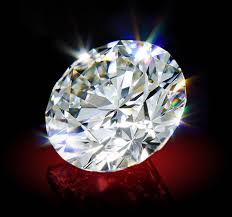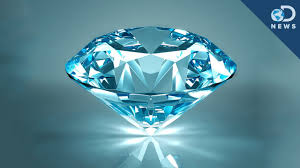|
Remarkable
facts:
- All diamonds are
at least 990,000,000 years old.
Many are 3,200,000,000 years old (3.2 billion years)!!!
How do we know this?
Age: from Carbon
dating? NO! C-dating only works for very young
carbon. You need to use other radioactive decay schemes (e.g., uranium-lead)
to date inclusions in diamonds. Inclusions used for dating are around 100
microns in diameter (0.1 mm).
- Diamonds are
formed deep within the Earth: between 100 km and 200 km below the
surface.
Diamonds form under remarkable conditions!
- The temperatures
are about 900 - 1300 C in the part of the Earth's mantle where diamonds
form.
- The pressure is
between 45 - 60 kilobars. (kB)
- 50 kB = 150 km =
90 miles below the surface
- 60 kB = 200 km =
120 miles below the surface
- Diamonds are carried to the surface by volcanic
eruptions.
The volcanic magma conduit is known as a kimberlite pipe or
diamond pipe. We find diamonds as inclusions in the (rather ordinary
looking) volcanic rock known as kimberlite.
NOTE: The kimberlite
magmas that carry diamonds to the surface are often much younger than the
diamonds they transport (the kimberlite magma simply acts as a conveyer
belt!).

- Diamond is made
of carbon (C), yet the stable form (polymorph) of carbon at the Earth's
surface is graphite.
- To ensure they
are not converted to graphite, diamonds must be transported extremely
rapidly to the Earth's surface.
It is probable that kimberlite lavas
carrying diamonds erupt at between 10 and 30 km/hour (Eggler, 1989).
Within the last few kilometers, the eruption velocity probably increases
to several hundred km/hr.
- Diamond is the hardest material.
Diamond is the hardest gem on the MOHS
harness scale and graphite (also made from carbon atoms) is
the softest! Given that both diamond and graphite are made of carbon,
this may seem surprising.
- Diamonds are found in many localities,
both overseas and in the US.
-
-

|
|
How many grams do you need to
mine to get 5 grams of diamonds?
(5g/1000 kg) @ 1000 g/kg = 5 g /1,000,000 g!
But only 20 % are
gem quality (80 % of these are sold in a "managed selling
environment") and the remainder are used for industrial purposes (this
material is known as "bort" or "carbonado" (carbonado is
finer)).
|
|
Basic Data
· Hardness = 10
· This is
what crystals look like before they are faceted: note their natural octahedral
shape! Uncut diamonds are also found in cubic
forms.
· Diamond
has four good cleavages, thus diamonds tend to cleave on impact.
· Refractive
Index = 2.42
· Dispersion=0.044
· Specific Gravity = 3.52
|
|
Value
The 4
"C" words are used to summarize the value determining factors:
The required basic information describing what is meant by these terms is
provided below.
blueish-white -> white -> silver -> yellow
- 'Fancy', or
strongly colored
stones have their own appeal and special value.
- Colored diamonds
may be
yellow, green or brown,
green or shades of pink.
- Larger
pink diamonds are quite rare and currently very expensive.
- Natural blue diamonds contain the element
boron (B), and this changes the conductivity of the diamonds.
Natural yellow diamonds contain the element nitrogen (N).
|
- Clarity is decreased by the presence of blemishes
or flaws, scratches, nicks, 'naturals' (the original surface of an uncut
stone).
- There are many
systems of nomenclature.
- Some terms include:
- perfect
- flawless
- imperfect
- very slightly
included
- very very
slightly included
|
IF
|
VVS1
|
VVS2
|
VS1
|
VS2
|
SI1
|
SI2
|
I1
|
I2
|
I3
|
|
internally flawless
|
very, very slightly included
|
|
very slightly included
|
|
slightly included
|
|
|
|
imperfect
|
- other descriptions:
- "Perfect,"
"internally flawless," and "flawless" are not
synonymous. "Flawless" is reserved for diamonds having no
visible inclusions under 10x magnificantion and having no external
blemishes of any kind.
- Clarity grades
refer to what is visible at 10x magnification. With sufficient
magnification, inclusions will be revealed in any diamond.
"Perfection" is relative.
- "pique"
(used below and in older literature) is an old trade term and has been
supplanted by the GIA-developed international standard, from IF to I3.
- "first
pique" inclusions readily recognizable at 10x mag., not
significantly diminishing brilliance
- "second
pique" larger inclusions, can be seen with naked eye
- "third
pique" many large inclusions, diminishing brilliance
- Examples of
clarity-reducing inclusions:
|
- Cut:
Facets are placed so as to maximize the brilliance and fire of a stone.
- Remember that in
the first lecture we talked about how the proportions
of a faceted gemstone are determined based on the refractive index?
- Review the basic
concepts:
- Refraction
is dependent upon the wavelength.
- Refractive Index
(RI) is proportional to wavelength; red RI < violet RI (dispersion
is due to the different amounts different wavelength are bent).
- Fire,which
is seen as rainbows and glints of color, is due to dispersion (a
consequence of the placement of faces on the crown to take advantage
of the prism
effect).
- The
brilliant cut (modern round brilliant cut or Tolkowsky cut)
is a typical cut chosen for diamonds. Tolkowsky determined the optimal
proportions are such that the table width is 53% of the diameter of the
cut stone. Appraisers will penalize diamonds with tables above 64%.
Significant deviations, up to table widths of more than 70% are not
uncommon.
- There are many
alternative diamond cuts.
- A poorly cut stone
is characterized by poorly chosen proportions (poor optimization of
brilliance and fire or, worse still, leakage of light from the
pavillion). Misplaced facets, extra facets, and problems at facet
junctions are also characteristics that reduce the quality
of "cut".
- Ranking: VERY
GOOD ... GOOD .... MEDIUM ... POOR
|
- Carat Weight
- Recall: 1 carat = 0.2 g, thus 5 carats=1g
- For example, compare
the size of a one point diamond to that of a 0.67 carat
diamond.
|
|
|

 84 members
84 members
Post a Comment